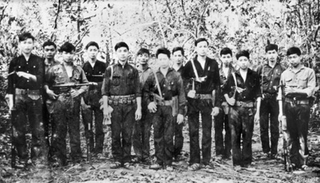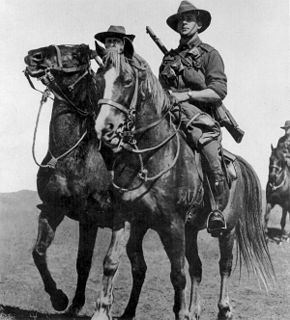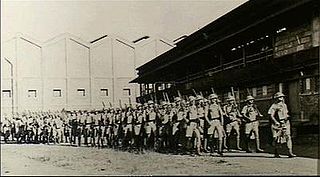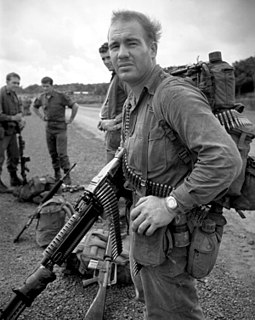
The 4th Battalion, Royal Australian Regiment was an Australian Army infantry battalion and part of the Royal Australian Regiment. The battalion was formed on 1 February 1964 and was renamed the 2nd Commando Regiment on 19 June 2009.

The Battle of Coral–Balmoral was a series of actions fought during the Vietnam War between the 1st Australian Task Force and the North Vietnamese 7th Division and Viet Cong Main Force units, 40 kilometres (25 mi) north-east of Saigon. Following the defeat of the communist Tet offensive in January and February, in late April two Australian infantry battalions—the 1st and 3rd Battalions of the Royal Australian Regiment (RAR)—with supporting arms, were again deployed from their base at Nui Dat in Phước Tuy Province to positions astride infiltration routes leading to Saigon to interdict renewed movement against the capital. Part of the wider allied Operation Toan Thang I, it was launched in response to intelligence reports of another impending communist offensive, yet the Australians experienced little fighting during this period. Meanwhile, the Viet Cong successfully penetrated the capital on 5 May, plunging Saigon into chaos during the May Offensive in an attempt to influence the upcoming Paris peace talks scheduled to begin on the 13th. During three days of intense fighting the attacks were repelled by US and South Vietnamese forces, and although another attack was launched by the Viet Cong several days later, the offensive was again defeated with significant losses on both sides, causing extensive damage to Saigon and many civilian casualties. By 12 May the fighting was over, and the North Vietnamese and Viet Cong were forced to withdraw having suffered heavy casualties. US casualties were also heavy and it proved to be their most costly week of the war.

Australia's involvement in the Vietnam War began with a small commitment of 30 military advisors in 1962, and increased over the following decade to a peak of 7,672 Australian personnel following the Menzies Government's April 1965 decision to upgrade its military commitment to South Vietnam's security. By the time the last Australian personnel were withdrawn in 1972, the Vietnam War had become Australia's longest war, and was only recently surpassed by Australia's long term commitment of combat forces to the War in Afghanistan. It remains Australia's largest force contribution to a foreign conflict since the Second World War and was also the most controversial in Australian society since the conscription controversy during the First World War. Although initially enjoying broad support due to concerns about the spread of communism in Southeast Asia, a vocal anti-war movement developed in response to Australia's programme of conscription.

The 7th Battalion, Royal Australian Regiment is a regular infantry battalion of the Australian Army. It was originally raised in 1965 as part of Australia's commitment to the Vietnam War and it eventually served two tours in Vietnam in 1967 and 1971. In 1973, following Australia's withdrawal from the conflict, the battalion was amalgamated with the 5th Battalion, Royal Australian Regiment to form the 5th/7th Battalion, Royal Australian Regiment.

The Battle of Binh Ba, also known as Operation Hammer, was a battle during the Vietnam War. The action occurred when Australian Army troops from the 5th Battalion, Royal Australian Regiment fought a combined communist force of North Vietnamese Army and Viet Cong, including a company from the 33 NVA Regiment and elements of the Viet Cong D440 Provincial Mobile Battalion, in the village of Binh Ba, 5 kilometres (3.1 mi) north of Nui Dat in Phuoc Tuy Province. The battle was unusual in Australian combat experience in Vietnam as it involved fierce close-quarter house-to-house fighting, although the majority of enemy killed was through heavy artillery and air-bombardment. In response to communist attempts to capture Binh Ba the Australians assaulted the village with infantry, armour and helicopter gunships, routing the Viet Cong and largely destroying the village itself. Such battles were not the norm in Phuoc Tuy, however, and the heavy losses suffered by the communists forced them to temporarily leave the province. Although the Australians did encounter communist Main Force units in the years to come, the battle marked the end of such large-scale clashes, and ranks as one of the major Australian victories of the war.

Operation Bribie, also known as the Battle of Ap My An, was fought during the Vietnam War in Phuoc Tuy province between Australian forces from the 6th Battalion, Royal Australian Regiment and two companies of Viet Cong from D445 Battalion, likely reinforced by North Vietnamese regulars. During the night of 16 February the Viet Cong attacked a South Vietnamese Regional Force compound at Lang Phuoc Hai, before withdrawing the following morning after heavy fighting with South Vietnamese forces. Two hours later, a Viet Cong company was reported to have formed a tight perimeter in the rainforest 2 kilometres (1.2 mi) north of Lang Phuoc Hai, near the abandoned hamlet of Ap My An. In response, the Australians deployed a quick reaction force. Anticipating that the Viet Cong would attempt to withdraw, as they had during previous encounters, forces from the 1st Australian Task Force were inserted to block the likely withdrawal route in the hope of intercepting and destroying them.
The 9th Battalion, Royal Australian Regiment was a Regular light infantry battalion of the Australian Army. The battalion was raised in November 1967 and deployed to South Vietnam as part of Australia's commitment to the Vietnam War in November 1968. 9 RAR served a year-long tour of duty based out of Nui Dat conducting operations mainly in Phuoc Tuy Province as part of the 1st Australian Task Force. The Battalion returned to Australia in November 1969 and was reformed at Enoggera, Queensland in January 1970 as part of the 6th Task Force, attached to the 1st Division. On 31 November 1973, following the withdrawal of Australian forces from South Vietnam and subsequent reduction of the Australian Army, the battalion was linked with the 8th Battalion, Royal Australian Regiment to form the 8th/9th Battalion, Royal Australian Regiment.

Operation Coburg was an Australian and New Zealand military action during the Vietnam War. The operation saw heavy fighting between the 1st Australian Task Force and North Vietnamese Army and Viet Cong during the wider fighting around Long Binh and Bien Hoa. American and South Vietnamese intelligence reports had indicated that an imminent communist offensive during the Tet New Year festival was likely, and in response the Australians and New Zealanders were deployed away from their base in Phuoc Tuy Province to bolster American and South Vietnamese forces defending the Long Binh–Bien Hoa complex north-east of Saigon. 1 ATF deliberately established fire support bases astride the communist lines of communication in the vicinity of the village of Trang Bom, expecting that they would attempt to destroy them. The Australians subsequently clashed with the Viet Cong during early patrols in Area of Operations (AO) Columbus, while later Fire Support Base (FSB) Andersen was repeatedly subjected to major ground assaults.

The Battle of Suoi Chau Pha was fought during the Vietnam War between Australian troops and the Viet Cong. The battle took place during Operation Ballarat, an Australian search and destroy operation in the eastern Hat Dich area, north-west of Nui Dat in Phuoc Tuy province. Following a covert insertion the day before which had caught a number of Viet Cong sentries by surprise, A Company, 7th Battalion, Royal Australian Regiment had patrolled forward unaware of the presence of a large Viet Cong main force unit nearby. Clashing with a reinforced company from the Viet Cong 3rd Battalion, 274th Regiment, a classic encounter battle ensued between two forces of roughly equal size. Fought at close quarters in dense jungle amid a heavy monsoon rain, both sides suffered heavy casualties as neither was able to gain an advantage. Finally, after a battle lasting several hours, the Australian artillery proved decisive and the Viet Cong were forced to withdraw, dragging many of their dead from the battlefield after having suffered crippling losses.

The 445th Battalion, also known as the D445 Provincial Mobile Battalion or the Ba Ria Battalion, was a Local Force battalion of the Viet Cong during the Vietnam War.

Major General Stuart Clarence Graham, was a senior officer in the Australian Army, seeing service during the Second World War, the Occupation of Japan and the Vietnam War. Born in Ulmarra, New South Wales, he graduated from the Royal Military College, Duntroon in 1940. Graham subsequently held a series of regimental and staff appointments, serving in a number of infantry and armoured units during the Second World War. In the post-war period he served in the British Commonwealth Occupation Force in Japan, and held a number of staff and command positions in the Armoured Corps. In the late 1950s he was posted to Army Headquarters, and later served as Director of Military Intelligence. Commanding the 1st Australian Task Force during fighting in South Vietnam during 1967, he was responsible for establishing the controversial barrier minefield from Dat Do to the coast. Later, Graham filled a range of senior command, staff and diplomatic roles in Australia and overseas, including the position of Deputy Chief of the General Staff (DCGS), before retiring in 1977. He died in 1996.

Brigadier Oliver David Jackson, was a senior officer in the Australian Army, seeing service during the Second World War and the Vietnam War. After graduating from the Royal Military College, Duntroon, in 1939 he served in the Middle East and New Guinea during the Second World War. Later, he commanded the Australian Army Training Team Vietnam (AATTV) and the Australian Army Force Vietnam (AAFV) in 1965–66. In 1966, he became the first commander of 1st Australian Task Force in South Vietnam. He subsequently filled a number of senior command and staff positions before retiring in 1974. He died in 2004.

Brigadier Stuart Paul Weir, was a senior officer in the Australian Army, seeing service during the Second World War, Korean War, the Malayan Emergency and the Vietnam War. He subsequently commanded the 1st Australian Task Force in South Vietnam in 1969–70.
This is an order of battle listing the Australian and Viet Cong forces involved in the Battle of Long Tan which occurred in Phuoc Tuy Province, South Vietnam on 18 August 1966.
The 1st Australian Civil Affairs Unit was raised in 1967 to coordinate the Australian Army's contribution to the US and allied Pacification Program during the Vietnam War, operating in Phuoc Tuy Province. Although other Australian units also conducted civic action projects in South Vietnam at various times, 1 ACAU had the primary responsibility for them once it was deployed. It was withdrawn from South Vietnam in November 1971.
Major General William George Henderson, was a senior officer in the Australian Army.
Operation Hardihood was a security operation conducted from 16 May to 8 June 1966 during the Vietnam War by the U.S. 503rd Infantry Regiment, the 1st Battalion, Royal Australian Regiment (1RAR) and the 5th Battalion, Royal Australian Regiment in Phước Tuy Province, South Vietnam to secure the area around Nui Dat for the establishment of a base area for the 1st Australian Task Force.

























